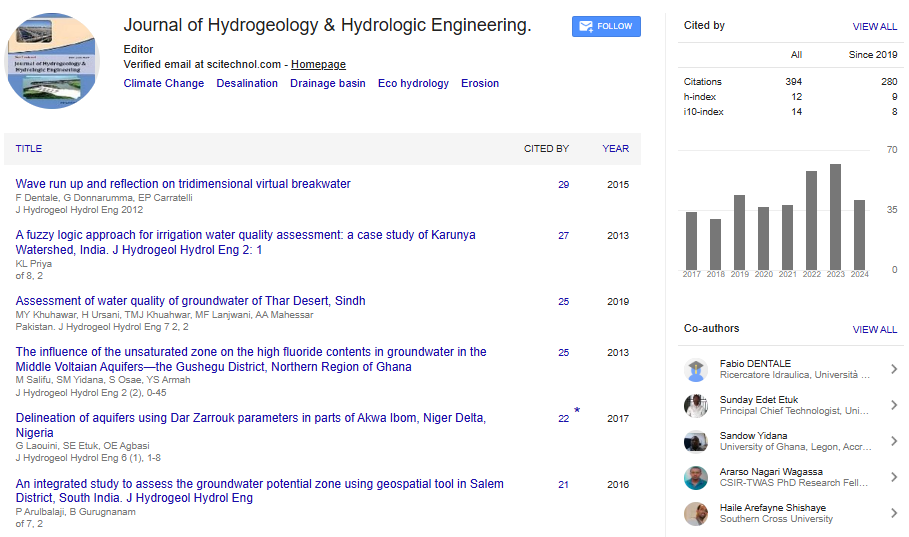Opinion Article, J Hydrogeol Hydrol Eng Vol: 13 Issue: 5
Hydrological Processing's Function in Water Environmental Management
Anika Muller*
1Department of Hydrologic Engineering, University of Sao Paulo, Sao Paulo, Brazil
*Corresponding Author: Anika Muller,
Department of Hydrologic Engineering,
University of Sao Paulo, Sao Paulo, Brazil
E-mail: mullera37@gmail.com
Received date: 23 September, 2024, Manuscript No. JHHE-24-153112;
Editor assigned date: 25 September, 2024, PreQC No. JHHE-24-153112 (PQ);
Reviewed date: 09 October, 2024, QC No. JHHE-24-153112;
Revised date: 16 October, 2024, Manuscript No. JHHE-24-153112 (R);
Published date: 24 October, 2024, DOI: 10.4172/2325-9647.1000348
Citation: Muller A (2024) Hydrological Processing's Function in Water Environmental Management. J Hydrogeol Hydrol Eng 13:5.
Description
Hydrological processing is an essential element in understanding water resources and managing them effectively. In a world increasingly affected by climate change, population growth and industrialization, efficient management of water resources has become more important than ever. Hydrological processing involves the analysis and simulation of water flow, distribution and quality within a hydrologic cycle, encompassing surface water, groundwater and atmospheric moisture. This article discusses the significance of hydrological processing, its methods and its impact on sustainable water management.
Hydrological processing is the practice of analyzing data related to the hydrological cycle and using this data to model and predict water behavior in various environments. By studying precipitation, evapotranspiration, infiltration and runoff patterns, scientists can understand the movement and storage of water in a given region. Hydrological processing includes both observational data collection, such as rainfall measurements and river discharge rates and modeling techniques that simulate water dynamics over time.
Advancements in technology, particularly in Geographic Information Systems (GIS) and remote sensing, have greatly enhanced hydrological processing. These tools allow scientists to collect accurate data on water bodies and their interactions with land and vegetation. Models built using hydrological processing are essential in predicting floods, droughts and changes in water availability, making this field fundamental for effective water resource management.
Hydrological processing starts with data collection on various water sources and movements. Rain gauges, stream gauges and remote sensing technologies are commonly used to gather this information. Data from these sources are analyzed to establish a baseline understanding of the water cycle in the region. Information on precipitation, soil moisture and evapotranspiration rates is essential for creating accurate models.
Geographic Information Systems (GIS) and remote sensing are valuable tools for hydrological processing. GIS provides spatial analysis capabilities, allowing researchers to visualize water distribution across large areas and identify patterns. Remote sensing data from satellites can provide real-time information on precipitation, land cover and temperature, enabling researchers to monitor water bodies and land surface interactions effectively.
Applications of hydrological processing
Hydrological processing has wide-ranging applications in water resource management, agriculture, urban planning and environmental conservation.
Water resource management: By understanding water cycles and predicting water availability, hydrological processing helps allocate resources efficiently. For example, it allows for the prediction of dry periods, ensuring that water reservoirs are maintained at optimal levels to meet agricultural and drinking water demands.
Agricultural planning: Hydrological processing helps farmers and agricultural planners anticipate rainfall patterns and manage irrigation systems accordingly. With climate change leading to unpredictable weather, this tool is essential in helping farmers adapt to new conditions and minimize water wastage.
Urban development: Urbanization affects natural water flow patterns, often increasing surface runoff and reducing groundwater recharge. Hydrological processing aids urban planners in designing effective drainage systems to manage stormwater and prevent urban flooding.
Environmental conservation: Hydrological models can reveal the impacts of land use changes, such as deforestation, on local water cycles. This information is valuable for conservation efforts, helping guide policies to protect watersheds and promote sustainable land use practices.
Challenges in hydrological processing
Despite its benefits, hydrological processing faces several challenges. The accuracy of hydrological models depends on the quality and availability of data, which can be difficult to obtain in remote areas. Additionally, climate change introduces variables that may not be fully accounted for in existing models. The complexity of natural water systems also means that even advanced models may struggle to capture all the nuances of the hydrological cycle, leading to potential inaccuracies in predictions.
Conclusion
Hydrological processing plays a vital role in understanding and managing water resources. From flood prediction to resource allocation, its applications impact agriculture, urban development and environmental conservation. Although challenges remain, advancements in technology and data collection continue to improve the accuracy and effectiveness of hydrological models. By investing in hydrological research and processing, societies can better prepare for water-related challenges, ensuring sustainable water resources for future generations.
 Spanish
Spanish  Chinese
Chinese  Russian
Russian  German
German  French
French  Japanese
Japanese  Portuguese
Portuguese  Hindi
Hindi 
